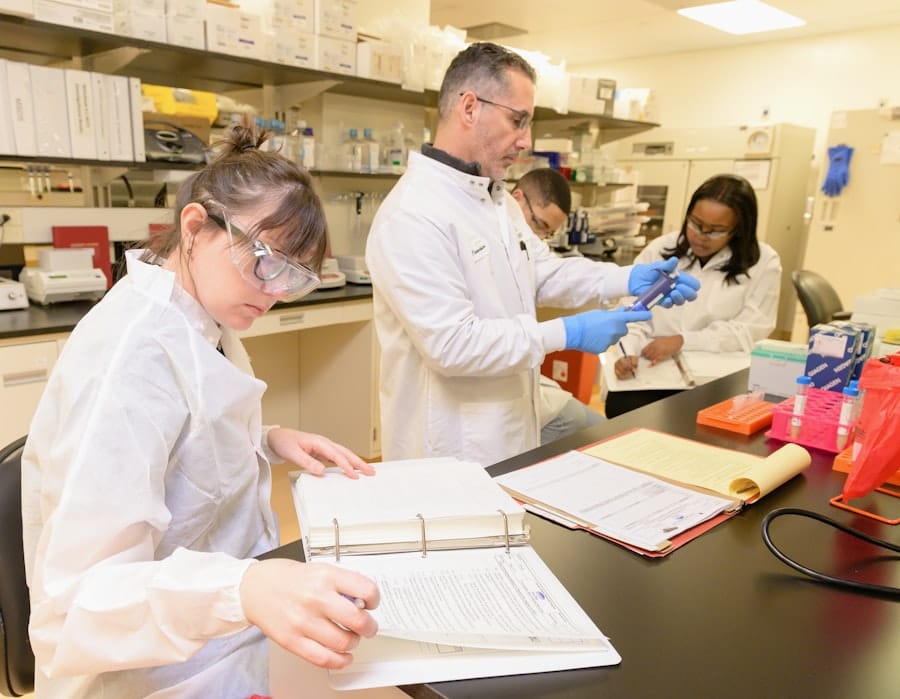Augmented Reality (AR) has emerged as a transformative technology in various fields, and its application in education, particularly in Science, Technology, Engineering, and Mathematics (STEM), is gaining significant traction. AR enhances the learning experience by overlaying digital information onto the physical world, allowing students to interact with complex concepts in a more intuitive and engaging manner. This technology bridges the gap between theoretical knowledge and practical application, making abstract ideas more tangible.
As educators seek innovative methods to captivate young minds, AR stands out as a powerful tool that can revolutionize how STEM subjects are taught. The integration of AR into STEM education is not merely a trend; it represents a paradigm shift in pedagogical approaches. By providing immersive experiences, AR enables students to visualize intricate processes, conduct virtual experiments, and explore scientific phenomena that would otherwise be inaccessible.
For instance, students can dissect virtual organisms or manipulate 3D models of molecular structures, fostering a deeper understanding of biological and chemical principles. As we delve into the benefits and applications of AR in STEM education for younger students, it becomes evident that this technology holds the potential to enhance learning outcomes significantly.
Key Takeaways
- AR in STEM education enhances learning by providing interactive and immersive experiences for students.
- Using AR in STEM education for younger students can improve understanding, retention, and engagement.
- AR applications in STEM education include virtual labs, 3D models, and interactive simulations.
- AR encourages engagement and collaboration in STEM learning by allowing students to work together in virtual environments.
- Addressing challenges and limitations of AR in STEM education involves ensuring access to technology and addressing potential distractions.
The Benefits of Using AR in STEM Education for Younger Students
One of the most compelling advantages of using AR in STEM education is its ability to cater to diverse learning styles. Younger students often exhibit varying preferences for how they absorb information—some may thrive on visual stimuli, while others may prefer hands-on experiences. AR effectively combines these modalities by providing visual representations that students can interact with physically.
For example, a student learning about the solar system can use an AR application to visualize planets orbiting the sun in real-time, allowing them to grasp concepts like scale and distance more effectively than through traditional textbook illustrations. Moreover, AR fosters an environment of active learning, where students are not passive recipients of information but active participants in their educational journey. This engagement is particularly crucial for younger learners, who may struggle with attention spans during conventional lectures.
By incorporating AR into lessons, educators can create interactive scenarios that require students to solve problems collaboratively or explore scientific concepts through guided discovery. This hands-on approach not only enhances retention but also cultivates critical thinking skills as students navigate challenges and make decisions based on their observations.
Examples of AR Applications in STEM Education

Numerous AR applications have been developed specifically for STEM education, each designed to address different aspects of learning.
When paired with compatible apps, the Merge Cube can transform into various objects—such as a human heart or a historical artifact—enabling students to explore these subjects from multiple angles.
This tactile interaction deepens understanding and encourages curiosity, as students can manipulate the cube to see how different systems work together. Another innovative application is “Google Expeditions,” which offers virtual field trips enhanced by AR technology. Students can embark on journeys to explore the depths of the ocean or the surface of Mars without leaving their classroom.
These immersive experiences not only provide context for scientific concepts but also inspire wonder and excitement about the natural world. By allowing students to experience environments and phenomena that are otherwise difficult to access, these applications broaden their horizons and stimulate interest in STEM fields.
How AR Encourages Engagement and Collaboration in STEM Learning
AR’s interactive nature inherently promotes collaboration among students, fostering teamwork and communication skills essential for success in STEM careers. When students engage with AR applications in groups, they often find themselves discussing their observations, sharing insights, and collectively solving problems. This collaborative environment mirrors real-world scientific inquiry, where teamwork is crucial for innovation and discovery.
For instance, during a project involving an AR simulation of an ecosystem, students can work together to manipulate variables such as temperature or pollution levels and observe the resulting changes in biodiversity. Furthermore, AR encourages peer-to-peer learning, where students can teach one another based on their unique perspectives and experiences with the technology. This dynamic not only reinforces their understanding but also builds confidence as they articulate their thoughts and findings to their classmates.
In this way, AR serves as a catalyst for social interaction within the classroom, transforming traditional learning into a more communal experience that values diverse contributions.
Addressing Challenges and Limitations of AR in STEM Education
Despite its numerous advantages, the integration of AR into STEM education is not without challenges. One significant barrier is the accessibility of technology; not all schools have the necessary resources or infrastructure to implement AR effectively. Devices such as tablets or smartphones are essential for running AR applications, and disparities in access can create inequities among students.
Additionally, educators may require training to effectively incorporate AR into their teaching practices, which can be a time-consuming process. Another limitation lies in the potential for distraction. While AR can enhance engagement, it can also lead to cognitive overload if not implemented thoughtfully.
Students may become so engrossed in the technology that they lose sight of the educational objectives. To mitigate this risk, educators must strike a balance between using AR as a tool for exploration and ensuring that it serves as a means to achieve specific learning outcomes. Careful planning and clear instructional goals are essential to harnessing the full potential of AR while minimizing its drawbacks.
Integrating AR into the Curriculum for Younger Students

To effectively integrate AR into the curriculum for younger students, educators must adopt a strategic approach that aligns with educational standards and learning objectives. One effective method is to design interdisciplinary projects that incorporate AR across various subjects within STEM education. For example, a project on renewable energy could involve using AR to visualize how solar panels convert sunlight into electricity while simultaneously exploring the science behind photosynthesis in plants.
This holistic approach not only reinforces concepts but also demonstrates the interconnectedness of different scientific disciplines. Professional development opportunities for teachers are also crucial in facilitating successful integration.
Collaborating with tech experts or partnering with educational institutions specializing in AR can provide valuable insights and resources for teachers looking to enhance their curriculum. By fostering a culture of continuous learning among educators, schools can ensure that they remain at the forefront of technological advancements in education.
The Future of AR in STEM Education for Younger Students
As technology continues to evolve, the future of AR in STEM education appears promising. Advancements in hardware and software will likely lead to more sophisticated applications that offer even richer interactive experiences for students. For instance, developments in artificial intelligence could enable personalized learning experiences where AR adapts to individual student needs and learning paces.
This level of customization could significantly enhance student engagement and comprehension by providing tailored content that resonates with each learner’s interests. Moreover, as educational institutions increasingly recognize the value of experiential learning, we may see a broader adoption of AR across curricula beyond STEM subjects. The potential for cross-disciplinary applications—such as integrating history with science through augmented reality simulations—could foster a more holistic educational experience for younger students.
As educators continue to explore innovative ways to engage students through technology, AR will likely play an integral role in shaping the future landscape of education.
The Impact of AR on the Future of STEM Education
The impact of augmented reality on STEM education for younger students is profound and multifaceted. By enhancing engagement through interactive experiences and fostering collaboration among peers, AR has the potential to transform traditional teaching methods into dynamic learning environments that inspire curiosity and innovation. As educators embrace this technology and integrate it thoughtfully into their curricula, they pave the way for a new generation of learners equipped with critical thinking skills and a passion for discovery.
As we look ahead, it is clear that augmented reality will continue to evolve alongside advancements in technology and pedagogy. The ongoing exploration of its applications will undoubtedly yield new insights into how we teach and learn within STEM fields. By harnessing the power of AR, educators can create immersive experiences that not only captivate young minds but also prepare them for future challenges in an increasingly complex world.
The journey toward integrating augmented reality into STEM education is just beginning, but its potential impact on shaping future innovators is already evident.
In the realm of educational technology, augmented reality (AR) is revolutionizing how younger students engage with STEM subjects, making learning more interactive and immersive. A related article that delves into the technological advancements in consumer electronics is The Best Toshiba Laptops 2023. This article explores the latest features and innovations in Toshiba laptops, which can be instrumental in supporting AR applications in educational settings. By integrating powerful computing devices with AR technology, educators can create dynamic learning environments that captivate and inspire students, fostering a deeper understanding of complex STEM concepts.
FAQs
What is AR?
AR stands for Augmented Reality, which is a technology that superimposes digital information such as images, videos, or 3D models onto the real world environment.
How does AR enhance STEM education for younger students?
AR enhances STEM education for younger students by providing interactive and immersive learning experiences. It allows students to visualize and interact with complex scientific concepts in a way that is engaging and easy to understand.
What are some examples of AR applications in STEM education?
Some examples of AR applications in STEM education include virtual dissection simulations, interactive 3D models of molecules and atoms, and augmented reality astronomy apps that allow students to explore the solar system.
What are the benefits of using AR in STEM education for younger students?
The benefits of using AR in STEM education for younger students include increased engagement, improved understanding of complex concepts, and the ability to cater to different learning styles. AR also encourages collaboration and problem-solving skills.
Are there any challenges in implementing AR in STEM education for younger students?
Challenges in implementing AR in STEM education for younger students include the cost of AR technology, the need for teacher training, and ensuring that the content aligns with educational standards. Additionally, access to AR devices and internet connectivity may be a barrier for some students.

